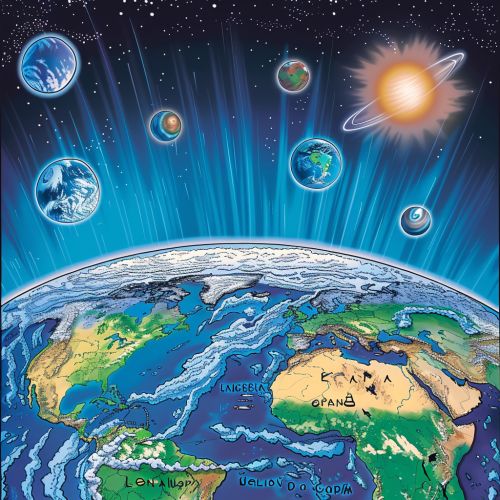Earth's Spheres
Earth's Spheres
The Earth is a complex system composed of various interconnected spheres that interact with each other in dynamic ways. These spheres include the Atmosphere, Hydrosphere, Lithosphere, Biosphere, and Cryosphere. Each of these spheres plays a crucial role in maintaining the balance and functionality of the Earth's environment.


Atmosphere
The atmosphere is the gaseous layer that envelops the Earth, extending from the surface to the edge of space. It is composed primarily of nitrogen (78%) and oxygen (21%), with trace amounts of other gases such as argon, carbon dioxide, and water vapor. The atmosphere is divided into several layers based on temperature gradients: the Troposphere, Stratosphere, Mesosphere, Thermosphere, and Exosphere.
The troposphere is the lowest layer, where weather phenomena occur and where the majority of the Earth's air mass is concentrated. The stratosphere contains the Ozone Layer, which absorbs and scatters ultraviolet solar radiation. The mesosphere is characterized by decreasing temperatures with altitude, and the thermosphere is where temperatures increase significantly due to the absorption of high-energy solar radiation. The exosphere is the outermost layer, gradually transitioning into outer space.
The atmosphere plays a critical role in regulating the Earth's climate, protecting life from harmful solar radiation, and facilitating the water cycle through processes such as evaporation, condensation, and precipitation.
Hydrosphere
The hydrosphere encompasses all water on Earth, including oceans, seas, lakes, rivers, groundwater, and glaciers. It covers approximately 71% of the Earth's surface and is essential for all known forms of life. The hydrosphere is in constant motion, driven by the Water Cycle, which involves the continuous movement of water between the atmosphere, land, and oceans through processes such as evaporation, transpiration, condensation, precipitation, and runoff.
Oceans are the largest component of the hydrosphere, holding about 97% of the Earth's water. They play a vital role in regulating the Earth's climate by absorbing and distributing solar energy and influencing weather patterns through ocean currents. Freshwater sources, such as rivers and lakes, are crucial for drinking water, agriculture, and industry.
Groundwater, found in aquifers beneath the Earth's surface, is another important component of the hydrosphere. It provides a significant source of freshwater for many regions, especially during dry periods. Glaciers and ice caps, part of the Cryosphere, store about 68.7% of the Earth's freshwater and play a key role in the global climate system by reflecting solar radiation and influencing sea levels.
Lithosphere
The lithosphere is the rigid outer layer of the Earth, comprising the crust and the uppermost part of the mantle. It is divided into tectonic plates that float on the semi-fluid Asthenosphere beneath. The lithosphere is responsible for the formation of various landforms, such as mountains, valleys, and plateaus, through processes like Plate Tectonics, Volcanism, and Erosion.
Plate tectonics is the movement of the Earth's lithospheric plates, driven by the heat from the Earth's interior. This movement leads to the formation of geological features such as mid-ocean ridges, subduction zones, and fault lines. Volcanism occurs when molten rock, or magma, from the mantle reaches the surface, forming volcanic landforms and contributing to the recycling of the Earth's crust.
Erosion, caused by wind, water, and ice, shapes the Earth's surface by wearing down rocks and transporting sediments. This process is essential for the formation of soil, which supports plant life and contributes to the Biosphere.
Biosphere
The biosphere encompasses all living organisms on Earth, including plants, animals, fungi, and microorganisms, as well as the ecosystems they inhabit. It extends from the deepest ocean trenches to the highest mountain peaks and interacts with the other spheres to sustain life.
The biosphere is characterized by Biodiversity, the variety of life forms and ecosystems. Biodiversity is essential for ecosystem stability, resilience, and productivity. It provides numerous ecosystem services, such as pollination, nutrient cycling, and climate regulation, which are vital for human well-being.
Ecosystems within the biosphere are interconnected through Food Webs and Nutrient Cycles. Food webs illustrate the flow of energy and nutrients between different organisms, while nutrient cycles, such as the Carbon Cycle and Nitrogen Cycle, describe the movement of essential elements through the environment.
Human activities, such as deforestation, pollution, and climate change, have significant impacts on the biosphere, leading to habitat loss, species extinction, and ecosystem degradation. Conservation efforts aim to protect and restore biodiversity to ensure the continued functioning of the biosphere.
Cryosphere
The cryosphere includes all frozen water on Earth, such as glaciers, ice caps, ice sheets, sea ice, and permafrost. It plays a crucial role in the Earth's climate system by reflecting solar radiation, regulating temperature, and influencing sea levels.
Glaciers and ice sheets, found primarily in Antarctica and Greenland, store vast amounts of freshwater and contribute to sea level changes through melting and calving. Sea ice, which forms and melts seasonally in polar regions, affects ocean circulation and weather patterns by influencing the exchange of heat and moisture between the ocean and atmosphere.
Permafrost, permanently frozen ground found in high-latitude regions, contains large amounts of organic carbon. Thawing permafrost due to global warming releases greenhouse gases, such as carbon dioxide and methane, into the atmosphere, exacerbating climate change.
The cryosphere is highly sensitive to temperature changes and serves as an indicator of global climate trends. Monitoring and understanding the cryosphere are essential for predicting future climate scenarios and assessing the impacts of climate change on the Earth's systems.
